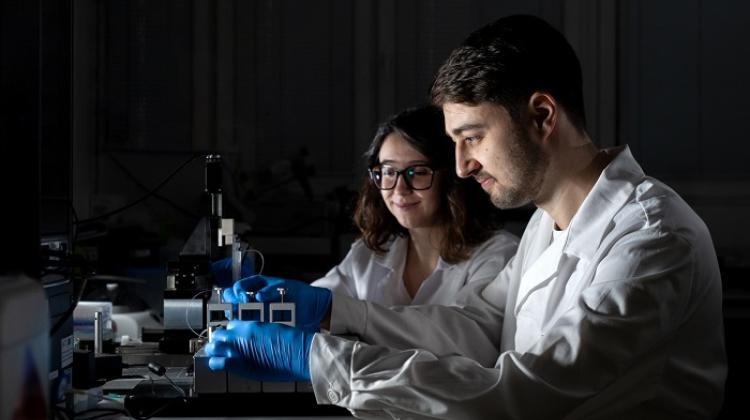Chemical snaps to bind nanoparticles to the substrate
 Various types of nanoparticles can be quickly and permanently bonded to the substrate, if you use one of the most effective methods of synthesis: click chemistry. The novel method has been presented by a team of researchers from the Institute of Physical Chemistry of the Polish Academy of Sciences. In the photo: Dr. Joanna Niedziółka-Jönsson and Dr. Adam Leśniewski with the study system. Source: Institute of Physical Chemistry PAS, Grzegorz Krzyżewski
Various types of nanoparticles can be quickly and permanently bonded to the substrate, if you use one of the most effective methods of synthesis: click chemistry. The novel method has been presented by a team of researchers from the Institute of Physical Chemistry of the Polish Academy of Sciences. In the photo: Dr. Joanna Niedziółka-Jönsson and Dr. Adam Leśniewski with the study system. Source: Institute of Physical Chemistry PAS, Grzegorz Krzyżewski
Nanoparticles can be quickly and permanently bonded to the substrate using chemical "snaps". A novel way of joining them has been developed at the Institute of Physical Chemistry PAS. Substrates generated this way can be used in the sensors detecting the presence of preservatives in food.
Nanoparticles can be bonded to the substrate as easily as snaps fasten clothing. Just a distinctive "click" and you\'re done. One of the newest synthesis methods of modern chemistry is similar: click chemistry. Particles are bound to form new chemical compounds by means of "snaps".
"Click chemistry is like building new structures with blocks. The blocks can be different chemical compounds, it is important to have a mating +snaps+. The problem arises when they do not have them. Then you have to consider whether you can somehow attach the appropriate +snap+ to particular type of blocks" - said Dr. Joanna Niedziółka-Jönsson from the Institute of Physical Chemistry PAS.
As reported by the Institute in the release sent to PAP, the main idea of the click chemistry was formulated in the last years of the twentieth century. "Chemistry carried out according to the +click+ method has many advantages. Many reactions here take place at low temperatures, and in a single solvent which often may be environment-friendly water. Moreover, the reaction yield is high: usually approx. 80-90 percent. The versatility, efficiency and selectivity of the click chemistry resulted in its considerable popularity, especially in the synthesis of new organic compounds" - reads the Institute release.
The click chemistry method has been used so far mainly for the synthesis of more complex organic compounds. Now scientists at the Institute of Physical Chemistry PAS demonstrated that chemical "snaps" can quickly, effectively and permanently bind much larger objects: gold nanoparticles with a glassy carbon substrate.
"Usually, nanoparticles are simply deposited on the substrate and connected by means of quite weak physical interactions, for example, electrostatic ones. We decided to show that using the click chemistry they can be chemically, covalently bonded to the substrate, so in a permanent way" - said Dr. Adam Leśniewski from the Institute of Physical Chemistry PAS, winner of the Iuventus Plus grant of the Ministry of Science and Higher Education, with which the project was funded.
Researchers used known chemical "snaps" to produce the binding: group of three nitrogen atoms (azides) which in the presence of a catalyst can bind with groups of carbon atom (terminal alkynes) located at the ends of other particles. As a result, both groups form stable nitrogen-carbon rings. In this study, azide groups were on the glassy carbon substrate and terminal alkynes on the surface of gold nanoparticles.
"We have worked with gold nanoparticles and carbon substrates, but our method is universal and in the future can be used to produce substrates from other materials" - said Dr. Niedziółka-Jönsson.
In the future, the variety of click chemistry proposed by researchers from the Institute of Physical Chemistry PAS may be used in the production of new, stable substrates for a variety of chemical sensors and electrodes used in flow systems. Sensors constructed based on such a substrates can be used, for example, to detect the presence of preservatives in foods.
PAP - Science and Scholarship in Poland
ekr/ mki/ mrt/
tr. RL
Przed dodaniem komentarza prosimy o zapoznanie z Regulaminem forum serwisu Nauka w Polsce.

















